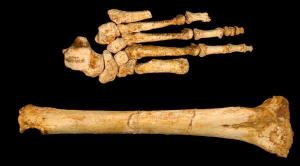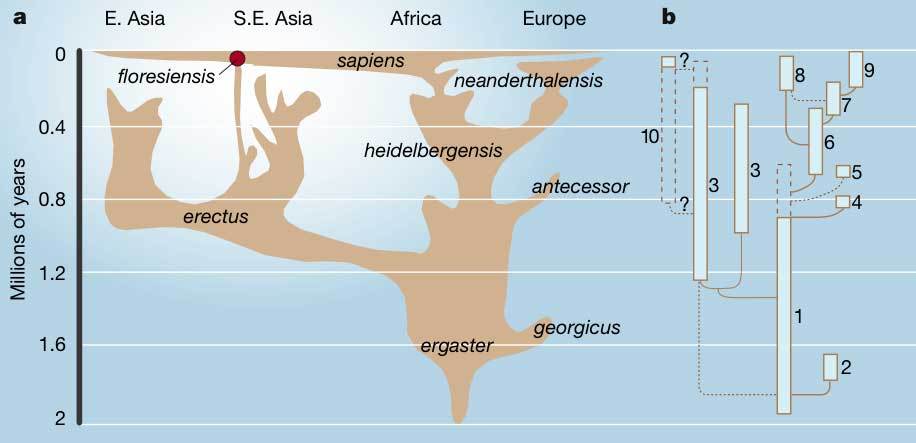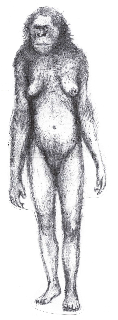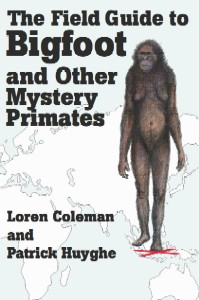
The long, flat “Hobbit ” foot next to the tibia. Both are from type specimen LB1. (Credit: W. Jungers)
May 18, 2009
Next month, there is forthcoming a special issue on the Liang Bua site of Homo floresiensis in the Journal of Human Evolution. (See “Articles in Press.”) Indeed, nine articles are “in press” for JHE on Homo floresiensis.
Meanwhile, a just published research paper, featured on the cover of the May 7, 2009, issue of Nature, addresses the question of the bipedal walk of the so-called “Hobbits” and why several features of their feet were so primitive that their gait was not efficient.
The second wave of acknowledgment and interest in Homo floresiensis appears to be beginning.

The long, flat “Hobbit ” foot next to the tibia. Both are from type specimen LB1. (Credit: W. Jungers)
The discovery that Homo floresiensis survived until so very recently, in geological terms, makes it more likely that stories of other mythical, human-like creatures such as Yetis are founded on grains of truth….Now, cryptozoology, the study of such fabulous creatures, can come in from the cold.Henry Gee, editor of Nature, “Flores, God and Cryptozoology,” 2004 editorial.
The Menehune of Hawaii and the Little People of Flores, the tiny 3 feet tall Homo floresiensis, appear to have a lot in common as Proto-Pygmies, it almost goes without saying.

The time is assuredly upon us to expand the Hobbit hunt. The systematic study of Proto-Pygmies in Oceania seems tied to the probable findings of future fossil evidence for Homo floresiensis beyond Flores. What is being discovered in Palau appears to be the latest reinforcement for such thoughts.

The 900-2,800-year-old “insular dwarf” remains from Palau seem to confirm traditions of “Little People” 2 or 3 feet tall from various Pacific islands. The best-known of these Pacific “Little People,” of course, are the Menehune of Hawaii. They are usually described as 2 to 3 feet tall, with short, stout, hairy, and quite muscular bodies, red-skinned faces, big eyes hidden by long eyebrows, low protruding foreheads, and short thick noses.
Luckily, I once journeyed to Hawaii over two decades ago, for a two-week stay with my son Malcolm and my wife-at-the-time. I spent time on Kauai investigating recent sightings of the Menehune seen around that island. My research resulted in the location photographs and content in the article, “The Menehune: Little People of the Pacific,” Fate, Vol. 4, No. 7, July, 1989.
I also summarized my investigations of the 1940s’ Waimea sightings of Menehune by school superintendent George London and about 45 children from two middle elementary level classrooms, on pages 148-149, of The Field Guide of Bigfoot and Other Mystery Primates.

Details of the encounter were recalled for me by Reverend Kenneth W. Smith, the pastor of Waimea’s Foreign Church, Christian Church and Hawaiian Church, who had spoken with many of the witnesses first hand. They told of seeing the Menehune playing around the large trees on the lawn of the parish property, which stands directly across the street from Waimea High School today.
I highly recommend that people in Hawaii visit that site today, as an interesting point in a cryptozoological tour of the islands.
As I have mentioned in talks and writings, there was actually a census done where Menehune were counted. An anthropological study of Menehune accounts authored by Katharine Luomala and published by the Bishop Museum in 1951, noted that 165 years previously, under the reign of Kaumualii, the last independent ruler of Kauai, a census of the population of the Wainiha Valley revealed that out of 2,000 people counted by the king’s agent, 65 were Menehune. Luomala herself wondered if the little people might be a "tribe of dwarfs."
In the field guide (page 148), I also mention the accounts of Menehune-like figures, "believed to be dwarfs," from the island of Fiji, southwest of Hawaii, according to the Fiji Times of July 19, 1975. The six witnesses to a mid-afternoon encounter described seeing eight figures, two feet tall and covered with black hair, run behind some bushes and disappear.
The Menehune of Hawaii directly relate to the reports of the Hobbits of Flores, Indonesia (see cover and pages xvi-xvii), and the Nittaewo of Ceylon/Sri Lanka (pages 128-129).
As T. Peter Park has noted to his colleagues: “The discovery of the Flores ‘Hobbits,’ who shared our planet with us as recently as 12,000 or 13,000 years ago, coupled with the native Flores tradition of the ebu gogo who sound very much like ‘Hobbit’ survivors in their own old haunts, have made ‘mainstream’ scientists more open than before to the idea that there ‘might well be something’ to native traditions and recent reports of hairy ‘little men’ on various Indonesian islands–especially Sumatra’s orang pendek. This was the view, for instance of Kate Wong, editorial director of ScientificAmerican.com, in the concluding paragraph of her ‘Hobbit’ article, ‘The Littlest Human,’ in the February 2006 Scientific American (Vol. 292, No, 2). She quoted Australian archaeologist Peter Brown, who also alluded to orang pendek, noting that ‘Every country seems to have myths about these things.’ Indeed, as Coleman’s & Huyghe’s Field Guide abundantly confirms, ‘It’s not at all silly to think there may well be populations of hidden hominids on just about every continent.'”

The front cover of The Field Guide to Bigfoot and Other Mystery Primates is illustrated with a drawing of Homo floresiensis by wildlife artist Richard Klyver, who studied for seven years among chimpanzees in Africa.
Consider a contribution of $100 or more to the International Cryptozoology Museum, and receive a personally signed copy of this field guide:
Thank you
About Loren Coleman
Loren Coleman is one of the world’s leading cryptozoologists, some say “the” leading living cryptozoologist. Certainly, he is acknowledged as the current living American researcher and writer who has most popularized cryptozoology in the late 20th and early 21st centuries.
Starting his fieldwork and investigations in 1960, after traveling and trekking extensively in pursuit of cryptozoological mysteries, Coleman began writing to share his experiences in 1969. An honorary member of Ivan T. Sanderson’s Society for the Investigation of the Unexplained in the 1970s, Coleman has been bestowed with similar honorary memberships of the North Idaho College Cryptozoology Club in 1983, and in subsequent years, that of the British Columbia Scientific Cryptozoology Club, CryptoSafari International, and other international organizations. He was also a Life Member and Benefactor of the International Society of Cryptozoology (now-defunct).
Loren Coleman’s daily blog, as a member of the Cryptomundo Team, served as an ongoing avenue of communication for the ever-growing body of cryptozoo news from 2005 through 2013. He returned as an infrequent contributor beginning Halloween week of 2015.
Coleman is the founder in 2003, and current director of the International Cryptozoology Museum in Portland, Maine.
Filed under Cryptomundo Exclusive, Cryptotourism, CryptoZoo News, Cryptozoologists, Cryptozoology, Eyewitness Accounts, Folklore, Homo floresiensis, Proto-Pygmies